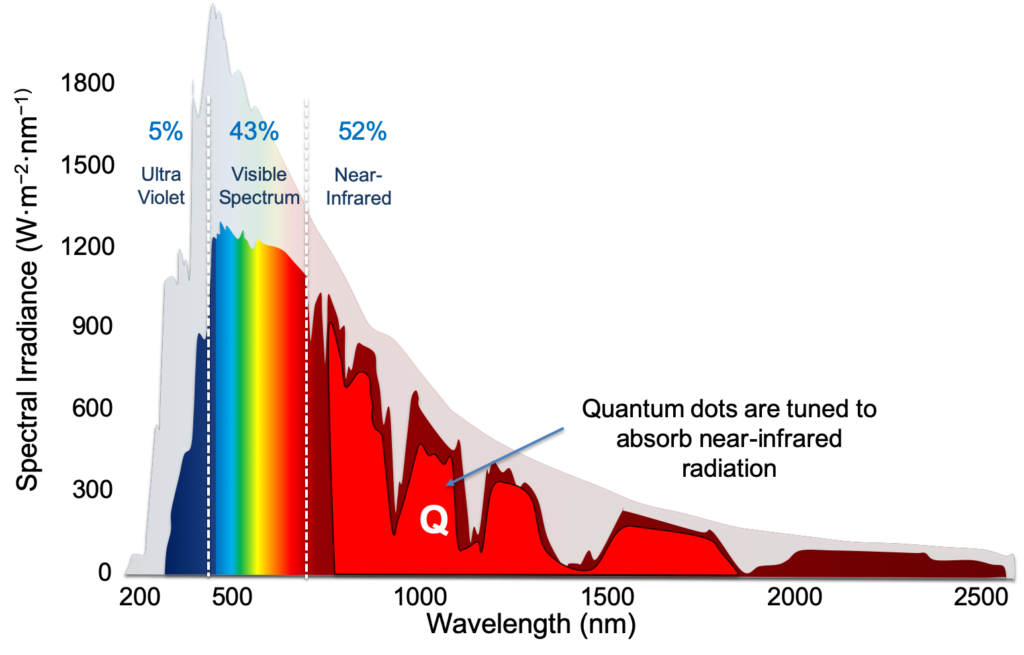Technology - (original) (raw)
Traditional solar technologies, such as the common silicon solar cell, only capture a fraction of the available solar radiation, because of their intrinsic material properties.

The gray area is the total light produced from the sun that reaches earth. The colored spectrum is the solar radiation that reaches sea level (the gaps are caused by light absorption by atmospheric gases). The light-blue area is the available radiation silicon turns into electricity. Much of the ultraviolet and near-infrared radiation is not efficiently harvested by silicon.
QD Solar can deliver much higher efficiencies and energy density
QD Solar has developed a product that will capture the full spectrum of the sun, thus delivering higher efficiencies and energy density that traditional solar technologies.
We use two highly complementary nanomaterials combined in a tandem cell architecture. Perovskites are used to absorb high-energy photons from the ultraviolet and visible parts of the spectrum and quantum dots are used to absorb photons from the near-infrared and infrared parts of the spectrum. This combination allows QD Solar to deliver highly efficient power-dense solar sheets.

Peroskites are very efficient at absorbing high-energy photons in the ultraviolet and visible spectrum. Absorption quickly drops off at 780 nm, making perovskites essentially transparent to the near-infrared spectrum where more than half of the total available energy is located.
What are perovskites?
Perovskites are a material class with the molecular structure ABX3. When applied to solar technology, they are often organic-inorganic hybrid compounds, in which the anions are halides (X), typically the A cations are a combination of lead and tin, and the B cations of organics and inorganics. Perovskites feature a broad absorption spectrum, fast charge separation, long transport distance of electrons and holes, and an extended carrier separation lifetime, making them a very effective solar material.
What are colloidal quantum dots?
Colloidal quantum dots are nanoscale semiconductor particles. Their bandgaps are tunable with the particle size, meaning that the size of the quantum dots determines the wavelengths at which they absorb light. This property makes them very for multi junction (tandem) solar cells. QD Solar has developed synthetic routes that can tune quantum dots for infrared absorption above 800 nm, making them complementary to perovskites in a tandem module.

By tuning the size of quantum dots, they can absorb the low-energy photons in the near-infrared and infrared spectrum above 800nm that pass through the perovskite layer.
What is a tandem solar module?

Our tandem module consists of two solar modules, each with different absorption materials with different wavelength sensitivity, stacked on top of each other. By combining our two complementary materials (perovskite and quantum dot), the resulting solar module can absorb a greater percentage of the available solar radiation. Our tandem solar modules require a mechanism, in the form of a smart junction box, to combine the power generated by the two solar cells.
Silicon versus Perovskites and Quantum Dots
Silicon

Silicon is a remarkable solar material, but comes with the limitation that it can harvest only a limited amount of the sun’s total radiation. It misses out on generating power from some of the ultraviolet spectrum energy as well as near-infrared radiation. This limits the potential for full radiation conversion.
Perovskite + Quantum Dots

By combining the ability of perovskites to capture the ultraviolet and visible spectrum and of quantum dots to capture the lower energy photons in the near-infrared and infrared part of the spectrum, QD Solar’s material is capable of absorbing a much larger percentage of the sun’s available radiation.
Silicon Cell Design
![]()
A traditional silicon solar panel is made up of many small silicon solar cells that are wired together and then laminated and framed into a panel, which is wired to a junction box.
Perovskite + Quantum Dot Panel Design

QD Solar-produced sheets contain both perovskites and quantum dot solar cells. These sheets are combined by panel manufacturers into a solar module by stacking the perovskite and quantum dot sheets on top of each other and laminating and framing them together into a perovskite and quantum dot solar panel. This panel is then wired to a smart junction box for power addition.
Stability
Together with our academic partners, we have performed extensive R&D testing to develop stable material compositions for the perovskite and quantum dot material classes. Using sophisticated encapsulation and protection technologies, we have successfully protected the materials from degrading, as verified by industry stablility tests in harsh conditions (elevated temperature and humidity). These tests are ongoing to demonstrate long-term stability.